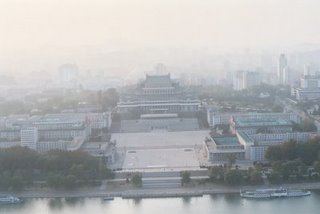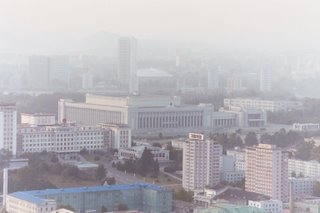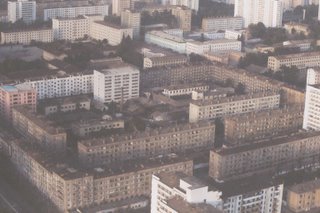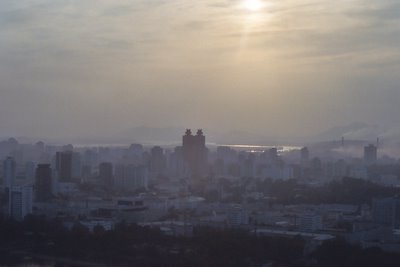
 Two large stone hanbok-clad women reach upward and across toward one another, arching over the road, together holding the Korean peninsula (complete with Uleung-do and Tok-do). It is the Monument to the Three Charters of Reunification. (here is a bit from KCNA). The three charters, as the government describes them, are “the three principles of national reunification, the ten-point programme of the great unity of the whole nation and the proposal on founding the DCRK advanced by the great leader.” The monument was completed on August 15, 2001.
Two large stone hanbok-clad women reach upward and across toward one another, arching over the road, together holding the Korean peninsula (complete with Uleung-do and Tok-do). It is the Monument to the Three Charters of Reunification. (here is a bit from KCNA). The three charters, as the government describes them, are “the three principles of national reunification, the ten-point programme of the great unity of the whole nation and the proposal on founding the DCRK advanced by the great leader.” The monument was completed on August 15, 2001. And then we were off to the Juche Tower, with the bus ride providing an opportunity for a lecture on Juche philosophy. Juche is “man” centered philosophy. If one can mobilize, organize and awaken the popular masses, they constitute a great power. If revolutionaries rely on the popular masses, they can ensure successful revolutions. In Juche, man is the master of everything. Man is the master of his own destiny, and therefore can shape destiny. (This starts to give some context to the infatuation with massive monuments and other assorted hero projects, as well as a little insight into Pyongyang’s behavior in the international community.)
And then we were off to the Juche Tower, with the bus ride providing an opportunity for a lecture on Juche philosophy. Juche is “man” centered philosophy. If one can mobilize, organize and awaken the popular masses, they constitute a great power. If revolutionaries rely on the popular masses, they can ensure successful revolutions. In Juche, man is the master of everything. Man is the master of his own destiny, and therefore can shape destiny. (This starts to give some context to the infatuation with massive monuments and other assorted hero projects, as well as a little insight into Pyongyang’s behavior in the international community.) The Juche calendar starts in 1912, the birth year of Kim Il Sung, but the concept of a Juche calendar did not come around until after Kim Il Sung’s death. (This is part of Kim Jong Il’s attempts to fully ingrain his father on all aspects of society, thus further legitimizing his rule.)
We drive on, a 60th anniversary of the Workers Party of Korea adding color to the scene. Out past the graying, dust covered buildings stands the glass and steel tower of a hotel. While there are storefronts and restaurants, the only open establishments appear to be the beauty salons. Schoolgirls walk by in pleated blue skirts with red scarves around their neck. People walk down the streets, some looking like farmers, others dressed in suits, leather jackets and fashionable women’s clothing.
 And we arrive at the Juche Tower. The tower stands along the river, offering an unsurpassed view of the city. The tower is made of 18 segments, plus the base and the torch. We walk through abandoned corridors, echoing and cold, to the single elevator and cram in for the ride to the top. Someone asks where the other numbered floors stop, the guide responds that there are no other floors. Either the numbers or the guide is misleading us.
And we arrive at the Juche Tower. The tower stands along the river, offering an unsurpassed view of the city. The tower is made of 18 segments, plus the base and the torch. We walk through abandoned corridors, echoing and cold, to the single elevator and cram in for the ride to the top. Someone asks where the other numbered floors stop, the guide responds that there are no other floors. Either the numbers or the guide is misleading us. 
And it’s off again to the next monument. We pass an older man with his bicycle by the side of the road near an apartment block, arguing heatedly with a blue-clad traffic lady. And we arrive at the Monument to the Workers’ Party of Korea, the three tools held aloft; the workers’ hammer, the farmers’ sickle and the intellectuals’ brush. Across the street from the monument lays a broad park, flanked by apartment complexes, with the image of Kim Il Sung in the distance, and behind that the pyramid hotel. In some ways it resembles the Mall in Washington DC.








No comments:
Post a Comment